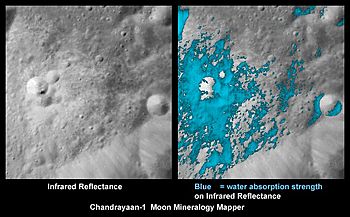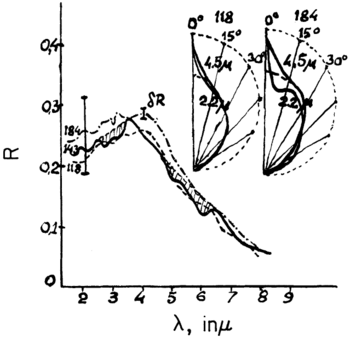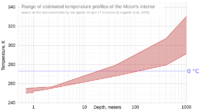Lunar water facts for kids

Lunar water is water that is present on the Moon. Diffuse water molecules can persist at the Moon's sunlit surface, as discovered by NASA's SOFIA observatory in 2020. Gradually water vapor is decomposed by sunlight, leaving hydrogen and oxygen lost to outer space. Scientists have found water ice in the cold, permanently shadowed craters at the Moon's poles. Water molecules are also present in the extremely thin lunar atmosphere.
Water (H2O), and the chemicals related hydroxyl group (-OH), exist in forms chemically bounded as hydrates and hydroxides to lunar minerals (rather than free water), and evidence strongly suggests that this is the case in low concentrations as for much of the Moon's surface. In fact, of surface matter, adsorbed water is calculated to exist at trace concentrations of 10 to 1000 parts per million. Inconclusive evidence of free water ice at the lunar poles had accumulated during the second half of the 20th century from a variety of observations suggesting the presence of bound hydrogen.
On 18 August 1976, the Soviet Luna 24 probe landed at Mare Crisium, took samples from the depths of 118, 143, and 184 cm of the lunar regolith, and then took them to Earth. In February 1978, it was published that laboratory analysis of these samples shown they contained 0.1% water by mass. Spectral measurements shown minima near 3, 5, and 6 µm, distinctive valence-vibration bands for water molecules, with intensities two or three times larger than the noise level.
On 24 September 2009, it was reported that the NASA's Moon Mineralogy Mapper (M3) spectrometer onboard India's Chandrayaan-1 probe had detected absorption features near 2.8–3.0 μm on the surface of the Moon. On 14 November 2008, India released the Moon Impact Probe onboard Chandrayaan-1 orbiter to impact into the Shackleton crater which helped confirm the presence of water ice. In August 2018, NASA confirmed that M3 showed water ice is present on the surface at the Moon poles. Water was confirmed to be on the sunlit surface of the Moon by NASA on October 26, 2020.
Water may have been delivered to the Moon over geological timescales by the regular bombardment of water-bearing comets, asteroids, and meteoroids or continuously produced in situ by the hydrogen ions (protons) of the solar wind impacting oxygen-bearing minerals.
The search for the presence of lunar water has attracted considerable attention and motivated several recent lunar missions, largely because of water's usefulness in rendering long-term lunar habitation feasible.
Possible water cycle
Production
Lunar water has two potential origins: water-bearing comets (and other bodies) striking the Moon, and in situ production. It has been theorized that the latter may occur when hydrogen ions (protons) in the solar wind chemically combine with the oxygen atoms present in the lunar minerals (oxides, silicates, etc.) to produce small amounts of water trapped in the minerals' crystal lattices or as hydroxyl groups, potential water precursors. (This mineral-bound water, or mineral surface, must not be confused with water ice.)
The hydroxyl surface groups (X–OH) formed by the reaction of protons (H+) with oxygen atoms accessible at oxide surface (X=O) could further be converted in water molecules (H2O) adsorbed onto the oxide mineral's surface. The mass balance of a chemical rearrangement supposed at the oxide surface could be schematically written as follows:
- 2 X–OH → X=O + X + H2O
or,
- 2 X–OH → X–O–X + H2O
where "X" represents the oxide surface.
The formation of one water molecule requires the presence of two adjacent hydroxyl groups or a cascade of successive reactions of one oxygen atom with two protons. This could constitute a limiting factor and decreases the probability of water production if the proton density per surface unit is too low.
Trapping
Solar radiation would normally strip any free water or water ice from the lunar surface, splitting it into its constituent elements, hydrogen and oxygen, which then escape to space. However, because of the only very slight axial tilt of the Moon's spin axis to the ecliptic plane (1.5 °), some deep craters near the poles never receive any sunlight, and are permanently shadowed (see, for example, Shackleton crater, and Whipple crater). The temperature in these regions never rises above about 100 K (about −170 ° Celsius), and any water that eventually ended up in these craters could remain frozen and stable for extremely long periods of time — perhaps billions of years, depending on the stability of the orientation of the Moon's axis.
While the ice deposits may be thick, they are most likely mixed with the regolith, possibly in a layered formation.
Transport
Although free water cannot persist in illuminated regions of the Moon, any such water produced there by the action of the solar wind on lunar minerals might, through a process of evaporation and condensation, migrate to permanently cold polar areas and accumulate there as ice, perhaps in addition to any ice brought by comet impacts.
The hypothetical mechanism of water transport / trapping (if any) remains unknown: indeed lunar surfaces directly exposed to the solar wind where water production occurs are too hot to allow trapping by water condensation (and solar radiation also continuously decomposes water), while no (or much less) water production is expected in the cold areas not directly exposed to the Sun. Given the expected short lifetime of water molecules in illuminated regions, a short transport distance would in principle increase the probability of trapping. In other words, water molecules produced close to a cold, dark polar crater should have the highest probability of surviving and being trapped.
To what extent, and at what spatial scale, direct proton exchange (protolysis) and proton surface diffusion directly occurring at the naked surface of oxyhydroxide minerals exposed to space vacuum (see surface diffusion and self-ionization of water) could also play a role in the mechanism of the water transfer towards the coldest point is presently unknown and remains a conjecture.
Liquid water
4–3.5 billion years ago, the Moon could have had sufficient atmosphere and liquid water on its surface. Warm and pressurized regions in the Moon's interior might still contain liquid water.
Uses
The presence of large quantities of water on the Moon would be an important factor in rendering lunar habitation cost-effective since transporting water (or hydrogen and oxygen) from Earth would be prohibitively expensive. If future investigations find the quantities to be particularly large, water ice could be mined to provide liquid water for drinking and plant propagation, and the water could also be split into hydrogen and oxygen by solar panel-equipped electric power stations or a nuclear generator, providing breathable oxygen as well as the components of rocket fuel. The hydrogen component of the water ice could also be used to draw out the oxides in the lunar soil and harvest even more oxygen.
Analysis of lunar ice would also provide scientific information about the impact history of the Moon and the abundance of comets and asteroids in the early Inner Solar System.
Ownership
The hypothetical discovery of usable quantities of water on the Moon may raise legal questions about who owns the water and who has the right to exploit it. The United Nations Outer Space Treaty does not prevent the exploitation of lunar resources, but does prevent the appropriation of the Moon by individual nations and is generally interpreted as barring countries from claiming ownership of Lunar resources. However most legal experts agree that the ultimate test of the question will arise through precedents of national or private activity.
The Moon Treaty specifically stipulates that exploitation of lunar resources is to be governed by an "international regime", but that treaty has only been ratified by a few nations, and primarily those with no independent spaceflight capabilities.
Luxembourg and the US have granted their citizens the right to mine and own space resources, including the resources of the Moon. US President Donald Trump expressly stated that in his Executive Order of 6 April 2020.
See also
 In Spanish: Agua lunar para niños
In Spanish: Agua lunar para niños
- Missions mapping lunar water
- Chandrayaan-2 lunar orbiter and rover




